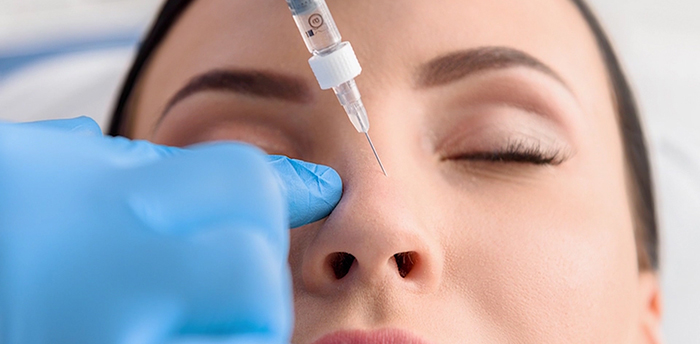If the face were a theater, your nose sits center stage. It helps explain why it is so upsetting for patients when their nose is too big, too small, has a hump or the tip points downward. When a nose is out of proportion with the rest of the face, it can make a patient feel unattractive and self conscious. This, in turn, can adversely affect a person’s self esteem.
In the past, the only solution for a disharmonious nose was a surgical rhinoplasty – until now. One of the best things about the field of plastic surgery is that its members are always on the hunt for new solutions to old problems. The non-surgical rhinoplasty is an easy, safe, and effective method for re-shaping the nose using filler. Board certified plastic Dr. Steven Camp of Fort Worth, Texas discusses why this procedure has become such a big part of his practice.
What is a Non-Surgical Rhinoplasty?
According to the latest statistics from the American Society of Plastic Surgeons (ASAPS), there are close to 219,000 rhinoplasty procedures performed annually. That’s a lot of people who are unhappy with the look or shape of their nose! While it makes sense to reshape a nose that is too long or which has a bump by surgically removing excess cartilage or bone, can the same effect be achieved non-surgically?
In many patients, the answer is a resounding “yes.” A non-surgical rhinoplasty uses carefully placed filler to create a nose that is more in harmony with the rest of the face. The procedure has been around for about 4-5 years, and can be done safely. In Dr. Camp’s practice, he performs what he calls a three step non-surgical rhinoplasty. It always begins with an analysis of the patient’s anatomy and issues.
How Does a Non-Surgical Rhinoplasty Work?
Oftentimes, patients will have a bump in the upper portion of their nose. In a non-surgical rhinoplasty, instead of shaving down this bump, strategically placed filler is used to camouflage it instead. One of the great things about using filler on the nose is that the results may last awhile since this is an area of the face that doesn’t move a lot. Patients can expect their non-surgical rhinoplasty results to last 1-2 years or even longer.
In the middle portion of the nose, Dr. Camp often finds areas where there is a depression or some degree of fullness that the patient wants to hide. Again, filler is an ideal camouflaging agent – the same goes for the tip. He will use filler to create more definition and a more favorable angle. Many patients feels as if the tip of their nose actually bends downward when they smile or are in animation. “We can fix all of this with our three point plan,” explains Dr. Camp.
Benefits of a Non-Surgical Rhinoplasty
Dr. Camp begins at the top of the nose and works downward. “The key is to stay mid-line and to stay deep,” he shares. “The blood vessels to the nose run lateral to medial, so my staying mid-line and deep with a focused plan, you can get safe, reliable, consistent results with a non-surgical rhinoplasty.”
There are a couple of other huge benefits. The procedure is fast, only taking about 15-20 minutes. It’s performed in the office and you walk out the door with almost instant gratification. One of the biggest drawbacks to a surgical rhinoplasty or really any procedure performed in the nose is that it required one of the more prolonged recoveries. “We used to tell patients that it might take 6 months to a year to recover,” explains Dr. Camp.
With a non-surgical rhinoplasty, patients leave the office with a smoother nose right then and there. Dr. Camp captures this fact on his Instagram and Facebook feeds. While not sure about the procedure at first, “I’m a believer now.”
Are You a Candidate for a Non-Surgical Rhinoplasty?
Not everyone, unfortunately, is a good candidate for a non-surgical rhinoplasty. If a patient has an overly broad nasal profile and/or thick skin, a non-surgical rhinoplasty isn’t going to be ideal. It’s very hard to take a filler material that is moldable and that needs to be strategically placed in small amounts and make a difference that you can see through thick skin. The problem with a thick nose is that there is a danger that the surgeon may put too much pressure in a certain area that could create problems with healing.
An ideal candidate for a non-surgical rhinoplasty is a patient who has already had surgery or surgeries, but who still has a small abnormality. This may be better served with an office based procedure such as a non-surgical rhinoplasty than another surgery.
Great Results, Happy Patients!
Dr. Camp gets really excited about a non-surgical rhinoplasty because “it’s fun to see any project through to its completion.” Something fast like this where you can show the patient an immediate before and after while he or she sits in your office is a total game changer. With a non-surgical rhinoplasty, Dr. Camp can offer the right patient superior results with minimal downtime.
Furthermore, it allows patients to “try it before they buy it. ” If you have a small hump, but you’re not sure that you want to commit to surgery, this allows you to “preview” your results without a huge commitment of time or money.




















Facebook
Twitter
Instagram
YouTube
RSS